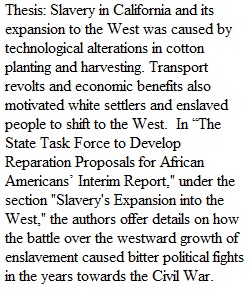


Q Paper #1 Governor Newsom asks you to write an evaluation of the State Task Force to Develop Reparation Proposals for African Americans’ Interim Report (https://oag.ca.gov/ab3121/reports), focusing upon the six pages that discuss Slavery in California. These are pages 67-73 (check page numbers not the PDF page counter) in the Interim Report are available at https://oag.ca.gov/system/files/media/ab3121-reparations-interim-report-2022.pdf He asks you to evaluate the history presented in that section, using the Kevin Waite book and any Lecture notes (but no online sources). Write a 750-1000 word evaluation that begins with a thesis (your argument about what the section does well and what the section gets wrong or leaves out), then in 2-3 body paragraphs gives evidence by comparing quotes from the report to details from the Waite book, then ends with a conclusion reflecting on whether the distinctions should make an impact upon Governor Newsom’s recommendation on reparations. --750 to 1000 words --Clear thesis --Body paragraphs that have clear points stated in topic sentences --Good use of evidence --Proper Citations Chicago Style --Well edited and clearly written Rubric Paper #1 Rubric Paper #1 Rubric Criteria Ratings Pts This criterion is linked to a Learning OutcomeThesis 20 to >17.0 pts A Contains an introductory paragraph that presents a clear argument/ overarching thesis. 17 to >15.0 pts B Contains an introductory paragraph with an acceptable argument/ thesis. 15 to >13.0 pts C Weak or unclear thesis. 13 to >0 pts D-F Weak or no thesis statement. 20 pts This criterion is linked to a Learning OutcomeOrganization 30 to >26.0 pts A Well-organized, structured paper with topic sentences and transitions that connect to thesis. Contains unified, coherent paragraphs. 26 to >23.0 pts B Most information is organized in a logical manner with transitions between most paragraphs and sometimes connects back to the thesis. 23 to >20.0 pts C Lacks organization and logical transitions and rarely connects to thesis. Does not convey information well. 20 to >0 pts D-F Lacks organization. Conveys information in a confusing manner that fails to connect to thesis. 30 pts This criterion is linked to a Learning OutcomeDevelopment 30 to >26.0 pts A Demonstrates excellent understanding of the assignment and addresses the question in a thoughtful, engaging manner. Shows strong knowledge of the topic. Excellent use of evidence from course material to support argument and points in each paragraph. 26 to >23.0 pts B Demonstrates sufficient understanding of the assignment and addresses the question posed. Shows adequate knowledge of the topic; most factual information is accurate. Uses evidence from the course material to support argument and points in some/most instances. 23 to >20.0 pts C Attempts to address the question, but fails to support thesis with details. Shows incomplete knowledge and includes errors. Fails to use adequate evidence from sources to support argument and points, or uses evidence improperly. 20 to >0 pts D-F Fails to address the question. Uses no evidence. 30 pts This criterion is linked to a Learning OutcomeMechanics 20 to >17.0 pts A Writing style is clear, concise, effective. Paper is free of grammatical, spelling, punctuation errors. Citations are accurate and consistent. 17 to >15.0 pts B Good sentence and paragraph structure. Few grammatical or spelling errors. No major writing errors. Citations are usually accurate and consistent. 15 to >13.0 pts C Poor sentence and paragraph structure. Some grammatical or spelling errors or major writing errors. Citations are inaccurate and inconsistent. 13 to >0 pts D-F Inadequate sentence and paragraph structure. Numerous grammatical or spelling errors. Many major writing errors. No citations. 20 pts Total Points: 100
View Related Questions